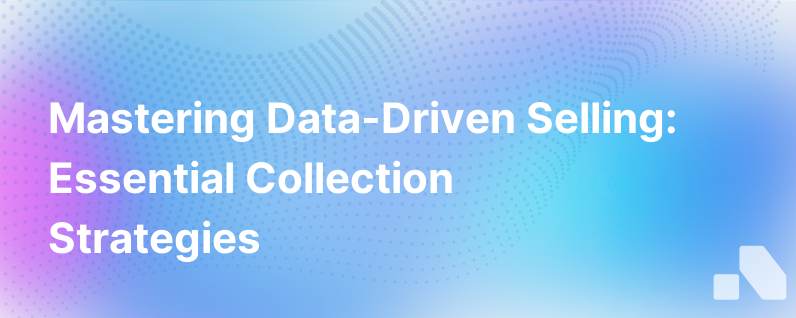
Data-driven selling is revolutionizing the way businesses approach sales, transforming intuition-based decision-making into strategic, evidence-based processes. In an increasingly competitive B2B marketplace, leveraging data effectively can offer a powerful advantage. As commerce becomes more complex, the foundations of data-driven selling become imperative, and the journey begins with one critical step: data collection.
Defining Data-Driven Selling
At its core, data-driven selling involves harnessing customer and market data to inform sales strategies, decisions, and actions. Sales teams use insights gleaned from data analysis to predict customer behavior, personalize outreach, streamline the sales process, and ultimately close more deals.
The Importance of Data Collection
For data-driven selling to be effective, the foundation must be robust, relevant, and actionable data. Collection is the first and most crucial phase, setting the stage for insight generation and strategy development. Simply put, without data, there are no insights, and without insights, a data-driven approach cannot exist.
The Types of Data to Collect
1. Customer Data: The data here includes demographics, firmographics, technographics, psychographics, contact information, and engagement history. The objective is to understand who your customers are, what they need, how they interact with your platform, and what drives their buying decisions.
2. Sales Process Data: This encompasses the data related to the sales pipeline and activities, such as lead response time, deal stages progression, length of the sales cycle, and conversion rates. Tracking and analyzing these metrics helps in improving the sales process over time.
3. Market Data: Key insights about market trends, industry shifts, competitor moves, and economic indicators fall under this category. They provide a wider perspective on where your product or sales tactics sit within the broader market context.
4. Product Usage Data: This refers to how your product or service is being used by customers, which features are most popular, and where users might be facing issues. It offers a direct line into the value that customers derive from your offerings.
5. Interaction Data: Finally, how customers and prospects interact with your website, content, emails, and customer service can reveal preferences, interests, and pain points crucial for sales engagement and content personalization.
Techniques for Data Collection
Data collection can seem overwhelming, but there are structured approaches to streamline the process:
1. Customer Relationship Management (CRM) Systems: CRMs are the backbone of data-driven sales teams, capturing interaction data, customer notes, and sales activities. A CRM not only organizes data but also ensures accessibility for analytics purposes.
2. Sales Enablement Tools: These tools can provide insights into how prospects engage with sales content, offering metrics on content effectiveness and customer interest levels.
3. Analytics Platforms: Marketing and sales analytics platforms track website visits, conversions, and other online customer behavior metrics, pooling a wealth of digital interaction data.
4. Surveys and Feedback Forms: Direct feedback from customers and prospects can yield quantitative and qualitative data that informs sales approaches and product development.
5. Third-party Data Services: For market and competitor data, third-party services can expand your dataset, providing broader insights that might be hard to capture internally.
Turning Collected Data into Actionable Insights
Once you've collected a broad spectrum of data, the focus shifts to analytics. The insights generated through analytics will guide strategic decision-making. For instance, a detailed analysis can uncover customer segments more likely to convert, the type of sales content that resonates the best with each segment, or common characteristics of the most lucrative deals.
For startups and SMBs, direct access to advanced analytics tools might be limited due to budgetary constraints. Nevertheless, solutions like Aomni bridge this gap, offering level-the-playing-field capabilities through robust AI and machine learning, providing actionable insights in an affordable and user-friendly package.
Data Hygiene and Governance
It's important to underline the necessity of ongoing data hygiene and governance practices. Inaccurate or outdated data can lead to flawed analyses, misguided strategies, and lost opportunities. Regularly cleansing and updating data sets, as well as maintaining strict data governance policies, ensures reliability and compliance with privacy regulations.
Challenges to Data Collection and Solutions
1. Data Silos: Data trapped in departmental silos hinder sales teams' ability to gain a holistic view. Integrated systems and cross-departmental collaboration enable a unified data landscape.
2. Data Overload: Collecting too much data without proper infrastructure can lead to analysis paralysis. Focusing on KPIs relevant to your sales process is central to making data manageable and useful.
3. Data Privacy Compliance: With regulations like GDPR and CCPA, it's crucial to navigate legal frameworks ethically and smartly while collecting and handling customer data.
Conclusion
The data-driven sales process is essential in today's sales landscape, with collection being a fundamental first step. By adopting a structured, diligent approach to collecting diversified sales data, companies can uncover rich, actionable insights that boost the efficiency and effectiveness of their sales teams. In a world where every percentage point of conversion rate translates into significant revenue growth, the value of a solid, data-driven foundation for selling cannot be overstressed. Using advanced analytics platforms like Aomni can empower teams to fully leverage their collected data, transforming numbers and metrics into powerful sales strategies.